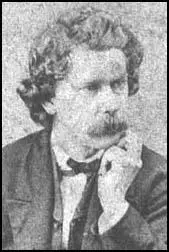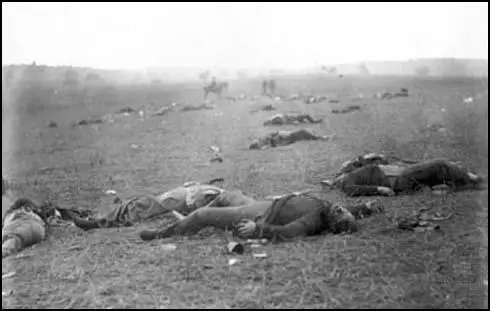Timothy O'Sullivan

Timothy O'Sullivan was born in New York City in about 1840. As a young man he was employed by the photographer, Matthew Brady. O'Sullivan went to work in his Washington studio where he served his apprenticeship under Alexander Gardner.
On the outbreak of the American Civil War there was a dramatic increase in the demand for work at Brady's studios as soldiers wanted to be photographed in uniform before going to the front-line. The following officers in the Union Army were all photographed at the Matthew Brady Studio: Nathaniel Banks, Don Carlos Buell, Ambrose Burnside, Benjamin Butler, George Custer, David Farragut, John Gibbon, Winfield Hancock, Samuel Heintzelman, Joseph Hooker, Oliver Howard, David Hunter,John Logan, Irvin McDowell, George McClellan, James McPherson, George Meade, David Porter, William Rosecrans, John Schofield, William Sherman, Daniel Sickles, George Stoneman, Edwin Sumner, George Thomas, Emory Upton, James Wadsworth and Lew Wallace.
In July, 1861, Matthew Brady and Alfred Waud, an artist working for Harper's Weekly, travelled to the front-line and witnessed Bull Run, the first major battle of the war. The battle was a disaster for the Union Army and Brady came close to being captured by the enemy.
Soon after arriving back from the front Matthew Brady decided to make a photographic record of the American Civil War. He sent O'Sullivan, Alexander Gardner, James Gardner, William Pywell, George Barnard, and seventteen other men to travel throughout the country taking photographs of the war. Each one had his own travelling darkroom so that that collodion plates could be processed on the spot. This included O'Sullivan's famous Harvest of Death, a photograph of dead soldiers at Gettysburg. and Dead Boy at Fredericksburg.
Matthew Brady continued to take credit for the photographs taken by his employees. Unhappy with this policy, O'Sullivan, like Alexander Gardner, left Brady and established his own photographic business. In 1870 he went to Panama as a photographer and between 1871 and 1874 carried out a series of photographic surveys of the United States.
Timothy O'Sullivan, who was appointed chief photographer for the Department of the Treasury in 1880, died of tuberculosis in Staten Island on 14th January, 1882.

Primary Sources
(1) A review of the exhibition of the photographs of Peninsula Campaign called Scenes and Incidents appeared in the New York World in July, 1862.
Brady's Photographic Corps, heartily welcomed in each of our armies, has been a feature as distinct and omnipresent as the corps of balloon, telegraph, and signal operators. They have threaded the weary stadia of every march; have hung on the the skirts of every battle scene; have caught the compassion of the hospital, the romance of the bivouac, the pomp and panoply of the field review.
(2) The New York Times on the photographs taken by Timothy O'Sullivan, Matthew Brady, Alexander Gardner , James Gardner and George Barnard (21st July, 1862)
Brady's artists have accompanied the army on nearly all its marches, planting their sun batteries by the side of our Generals' more deathful ones, and taking towns, cities and forts with much less noise and vastly more expedition. The result is a series of pictures christened Incidents of War, and nearly as interesting as the war itself: for they constitute the history of it, and appeal directly to the great throbbing hearts of the north.
